Ecology and Conservation of the American Crocodile (Crocodylus acutus) in Florida
Authors
Frank J. Mazzotti, Michael S. Cherkiss
Abstract
The American crocodile (Crocodylus acutus) is primarily a coastal crocodilian that is at the northern end of its range in southern Florida. In Florida, habitat loss from human development has been the primary factor in this endangered species decline. Currently, they face new issues--Florida Bay has undergone a number of changes that have caused a great deal of concern for the ecological health of this ecosystem and primary crocodile habitat. Efforts have been, and continue to be, made to improve Florida Bay and Biscayne Bay. In south Florida we have the unique opportunity to integrate endangered species conservation with ecosystem restoration and management. American crocodiles thrive in healthy estuarine environments, and are particularly dependent on freshwater deliveries. Recovery of the American crocodile in Florida will require an integration of habitat enhancement for an endangered species with environmental education. As crocodiles benefit from a restored freshwater flow into estuaries, their numbers will increase. The challenge of integrating a recovering population of the American crocodile with an ever increasing use of coastal areas by humans will require a proactive educational program and will be the final challenge in the successful recovery of this once critically endangered species.
Background
- The American crocodile is a primarily tropical species reaching the northern end of its range in southern Florida.
- Undiscovered until 1869, the American crocodile has always been considered rare in Florida.
- Habitat loss in southeastern Florida has been the primary reason for population decline.
- The American crocodile was listed as endangered by the USFWS in 1975.
 |
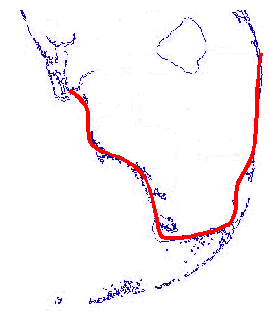 |
| Distribution of the American Crocodile | Historical distribution in Florida of the American crocodile |
Research, Monitoring and Modeling
- The population biology of the American crocodile in southern Florida has been studied through surveys for crocodiles and nests by a number of individuals and groups since the 1970's.
- Study areas have included Everglades National Park (ENP), Crocodile Lake National Wildlife Refuge (CLNWR), the Turkey Point Power Plant site (TP) and more recently Biscayne Bay and SW Florida.
- Our current efforts focus on determining the status of crocodiles in Florida as part of the Multi-Species Recovery Plan and evaluating the effects of alternative water delivery plans to the Everglades and Biscayne Bay estuaries as part of the Comprehensive Everglades Restoration Plan.
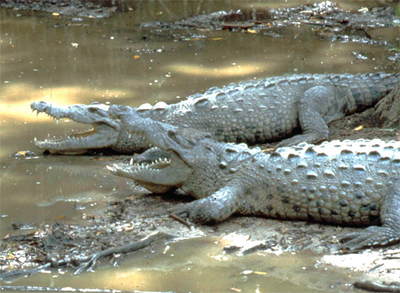
Methods and Results
- Distribution, relative abundance, habitat relation, growth and survival of crocodiles in Florida are determined by periodic surveys of crocodile habitat.
- Nesting effort and success are determined by searching known and potential nesting habitat during egg laying (April and May) and nest hatching (July and August).

Crocodile Nests in the Southern Tip of Florida and the Florida Keys
- Crocodiles now occur in areas where they never occurred before. Examples include public beaches, county parks, marinas, golf courses, and an airport.
- This has caused a growing problem with human/crocodile interactions. Out of miseducation and fear people react to crocodiles as a threat and nuisance rather than a natural history attraction and endangered species success story.
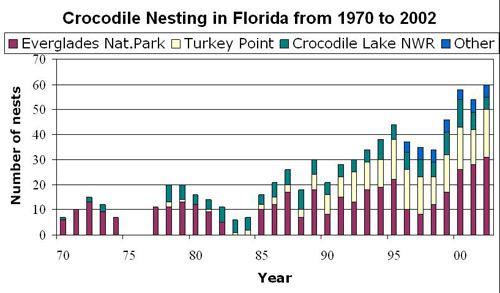
- The number and range of crocodiles and nests has increased in the last 25 years. Crocodiles have reoccupied southern Biscayne Bay and are found in Broward and Collier Counties.
- Most of the increase in crocodile nests has occurred on artificial substrates. This has to some extent compensated for the loss of nest sites due to development.

- Crocodiles in the least physically altered habitats of ENP grow slower and have a lower survival rate than crocodiles in the more altered areas at TP and CLNWR.
- We hypothesize that reduced freshwater flows to estuaries has decreased the suitability of those habitats for crocodiles.
Evaluating Everglades Restoration
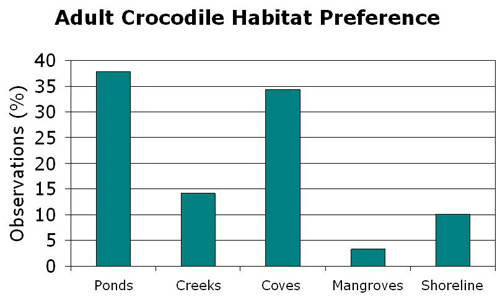
Success Criteria
- Resumption of natural freshwater flow volume and duration to the mangrove estuary will re-establish a salinity gradient with levels <20 ppt in shoreline and tidal creek habitats that will increase the growth and survival of juvenile crocodiles in ENP.
- Maintain current distribution of crocodiles throughout the mangrove transition zone. Increase relative abundance of crocodiles in areas with restored freshwater flow.
- In South Florida we have a unique opportunity to link endangered species conservation with ecosystem restoration and management.
- Crocodiles can be used to evaluate restoration alternatives and determine success criteria for Florida and Biscayne Bays.
Salinity Based Habitat Model
- A habitat suitability model was developed based on data from salinity and habitat relation of crocodiles in ENP and laboratory studies on crocodile growth rates.
- Crocodile habitat was identified as mangrove lined ponds, creeks, coves, and shorelines. Suitability was based on salinity with the most suitable areas defined as between 0-20 ppt, inter-mediate suitability as 20-40 ppt, and least suitable areas as greater than 40 ppt.
- Seasonal isohalines for the sample runs were based on SFWMD monthly water quality summaries.

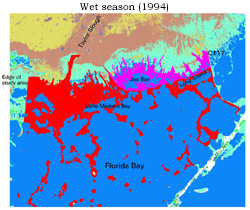
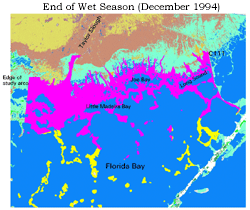
Arcview models of Crocodile habitat suitability of mangroves and coastal prairie in the wet and dry season 1994.
(click for larger images)
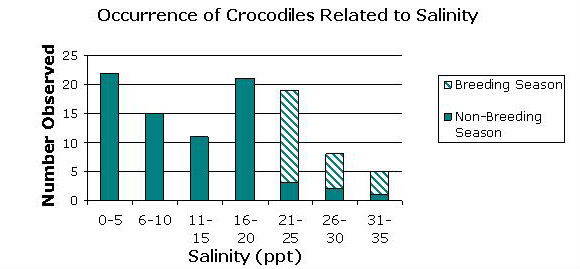
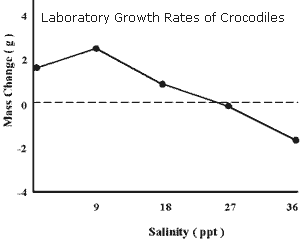
Implications
- More freshwater in northeastern Florida Bay increases the amount of suitable crocodile habitat.
- Under current conditions the most suitable crocodile habitat is closer to the C-111 drainage area than Taylor Slough.
- Increasing freshwater flows through Taylor Slough would produce more suitable crocodile habitat than current conditions.
Conclusions
The American crocodile has made a comeback in South Florida in areas where suitable habitat remains and in some areas where habitat modification has made it more attractive to crocodiles. Nesting habitat was inadvertently created through construction activities at the Turkey Point Power Plant site, at Crocodile Lake National Wildlife Refuge and other locations has to some extent compensated for the loss of nesting habitat elsewhere. Although the presence of crocodiles throughout south Florida is good news for this endangered species, it does present challenges for land and water managers. As crocodiles continue to increase in number and occupy new areas, encounters with humans will increase, thus, more complaints. Therefore we need a proactive educational program describing the recovery of this endangered species. This knowledge could be used to prepare people for the arrival of crocodiles into new areas and aid in the continuation of what is currently a successful recovery program.
Acknowledgements
This research was supported in significant part by DOI's Critical Ecosystem Studies Initiative, a special funding initiative for Everglades restoration administered by the National Park Service; and in part by USGS's Florida Caribbean Science Center and the US Fish and Wildlife Service. Additional funding was also provided by the National Park Service and the US Army Corps of Engineers. Funding in the past has also been provided by the South Florida Water Management District. Research permits and access to critical lands was provided by Everglades and Biscayne National Parks, Dade and Broward County Parks and Recreation, Ten Thousand Islands and Crocodile Lake National Wildlife Refuges, DEP's Rookery and Estero Bay Estuarine Preserves, and DEP's Division of Recreation and Parks. Thank you to the Florida Fish and Wildlife Conservation Commission and Turkey Point Florida Power and Light Company for data they contributed. A special thanks to everyone who has contributed to the field work.
Citation
Mazzotti, F.J. and M.S. Cherkiss. (2006) Ecology and Conservation of the American Crocodile (Crocodylus acutus) in Florida. Poster presented at the Greater Everglades Ecosystem Restoration Conference. Orlando, FL.
More About This Project
Status, Distribution, and Habitat Relations of the American Crocodile in Florida




